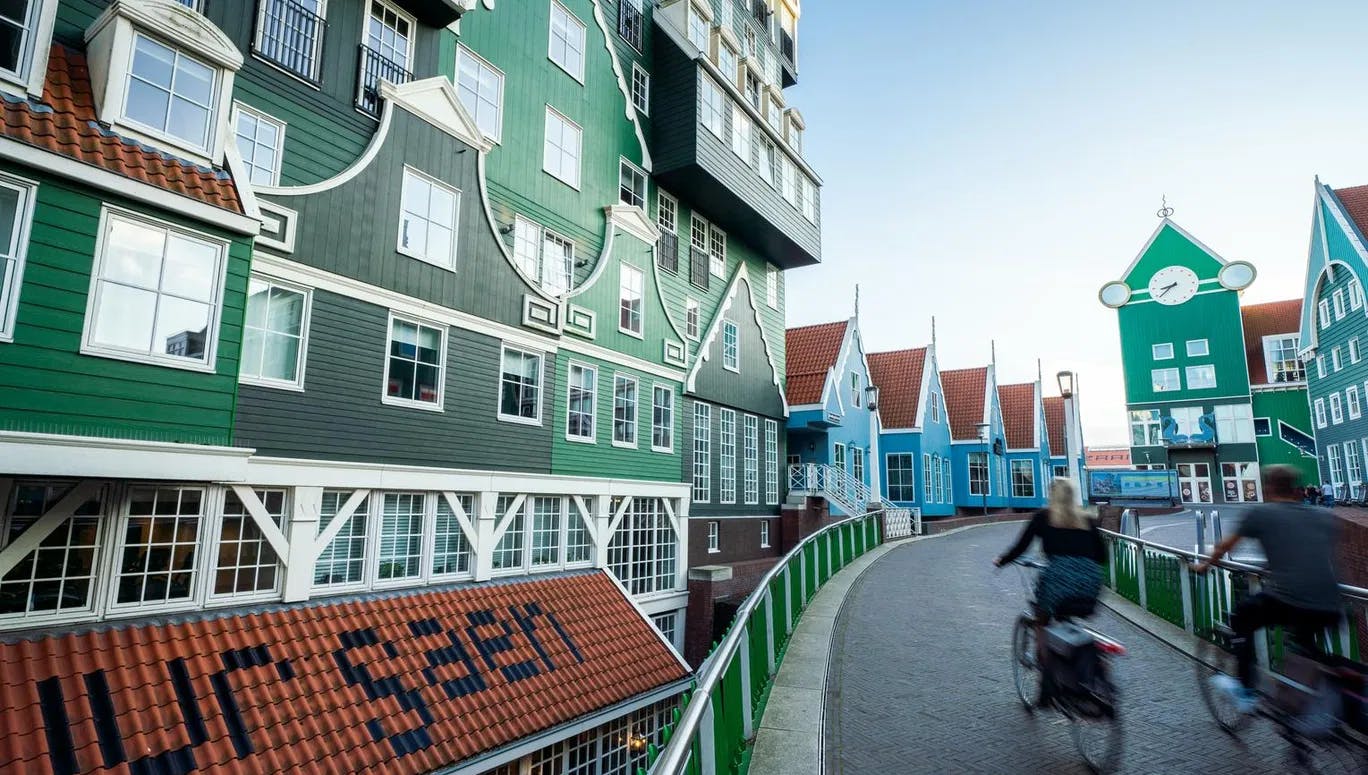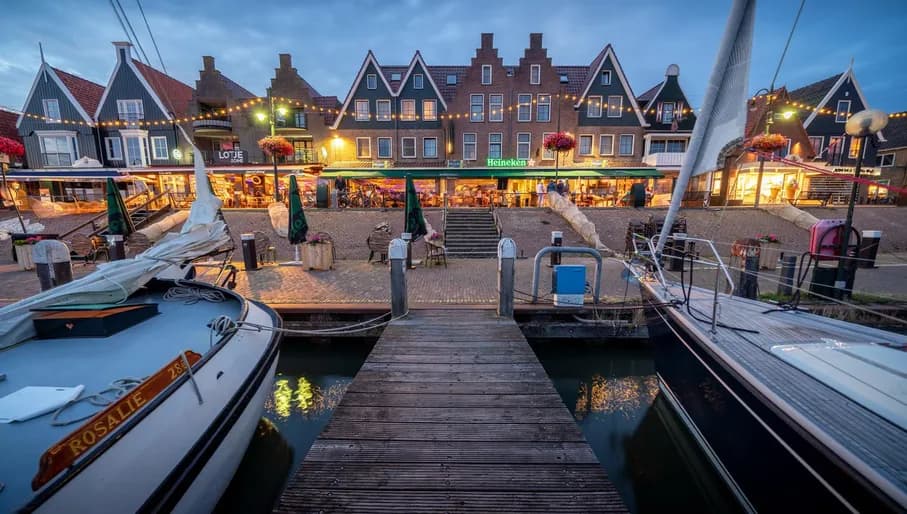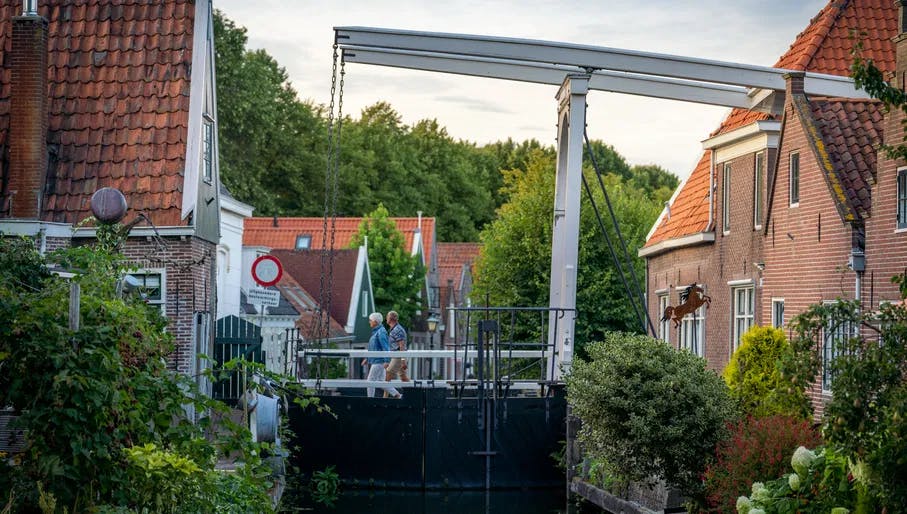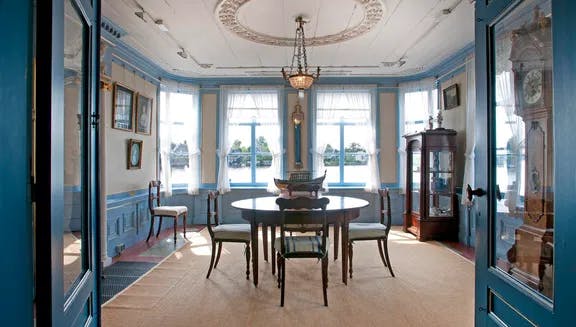
Things to do in Old Holland
Go windmill spotting at Zaanse Schans
Thanks to its awe-inspiring collection of perfectly preserved windmills, Zaanse Schans is the perfect introduction to Old Holland and the Zaanstreek region, which flourished from the 17th to 19th centuries as one of Europe's most important industrial areas. While the open-air museum can be visited any time of year, most windmills are open to visitors from April to October. Besides windmills, you can also visit the souvenir shops, see clogs being made or visit a cheese farm - offering a surprising and fun day out for all ages. The interactive Windmill Museum, only a 15-minute walk from Zaanse Schans, forms an excellent beginning or end point of a visit to the area. Here you can see countless paintings, models and original instruments that will transport visitors back in time. Read our guide to windmill spotting in and around Amsterdam for more.
Relax in an idyllic tea garden

Bare feet in the grass, a clucking chicken scurrying past and the aroma of a freshly baked cake wafting through the air: find true relaxation and pastoral dreams at one of Old Holland's idyllic tea gardens. Boat Rental Overleek, a 10-minute cycle from Monnickendam, has a beautiful veranda to relax on, and you can rent electrically propelled ‘whisper boats’ to explore the surrounding region. Alternatively, soak up the sunshine under the apple and pear trees of Theetuin Neckermolen in Wijdewormer - named after the picturesque local windmill. It doesn't get more quintessential Dutch countryside than this.
Eat fish in Volendam

The village of Volendam is known for its traditional costumes, music and fish, whilst the characteristic tiny houses, made incredibly picturesque by the beautiful harbour, create an atmosphere of friendliness and romance. You can’t visit Volendam without throwing your head back and eating some herring like the Dutch do. As the Netherlands’ most famous fishing village, there’s plenty of opportunity to get your hands on some fresh fish, whether it’s the less intimidating kibbeling — little pieces of fried fish — smoked eel, or the aforementioned herring, which is best eaten raw with onions. Visit a few fish stalls along the harbour, stroll along dyke as you watch the rippling water of the Markermeer or take a seat at one of the many seafood restaurants to get your fill.
Look beyond the cheese in Edam

Edam was once one of the country’s most important historic centres and its rich trading history is still visible today. It continues to be known worldwide for its eponymous cheese, which you can learn all about at the Story of Edam Cheese Museum. Of course, visiting in July and August when the famous cheese market is on is certainly a plus, but a tour of the town’s centuries-old buildings (such as the monumental Grote Kerk) and picturesque streets at any time delivers various sightseeing opportunities. Cruise the canals on a former cattle boat, taking in views of the traditional houses and hand-operated drawbridges. Roam through the dark passageways of Fort bij Edam, encountering fascinating hands-on exhibits dedicated to military history. And don’t miss the Edam Museum to find out all about the shipbuilding, timber and cheese-trading industries which built the wealth of this charming market town.
Cycle through the Beemster Polder

To discover one of the Netherlands’ UNESCO World Heritage Sites, it’s best to get on a bike. That’s because on two wheels, you can experience almost all the Beemster Polder, the country’s most famous polder. For the uninitiated, a polder is a piece of land reclaimed from the sea – and building these feats of engineering is a skill that the Dutch people have perfected throughout their history. The region boasts scenic waterways, dykes, forts, restored mills and traditional farmhouses - the old-style stolpboerderijen - such as those in the villages of Jisp and De Woude. Nearby you’ll also find De Rijp, dubbed ‘Holland’s most beautiful village’. Cycle around the area and marvel at the mansions lining the canals, or admire the famous De Eenhoorn farmhouse, a Dutch national heritage site that’s worth the trip alone. Be sure to start your visit at the Beemster Visitors Centre (VVV), which supplies walking and cycling routes and delicious regional products from the rich clay soil.
Stroll through Broek in Waterland

In the 17th and 18th centuries, the village of Broek in Waterland was the home of many successful shipowners, captains and merchants. Their wealth made it one of the most prosperous villages in the area. Today, the charming wooden houses - carefully restored and painted in authentic ‘Broeker’ grey - undoubtedly make for some of the prettiest views in Old Holland. Surrounded by green meadows, Broek in Waterland is a delightful place for a leisurely stroll or a pitstop as part of a cycling adventure if you wish to further explore the surroundings. Be sure to visit the beautiful church, the Broekerkerk, where you’ll find a tearoom and exhibitions by local artists inside.
Take a nature cruise

With its winding channels, unique vegetation, and exquisite bird-watching opportunities, the best way to experience the natural beauty of Old Holland is undoubtedly with a guided nature cruise. Under an experienced skipper's and nature guide's direction, the Visitor Centre De Poelboerderij organises various boat trips through the Womer and Jisperveld nature areas - the largest peat meadow in Europe. Many tours are themed, focussing on specific flora or bird of prey species or combined with an activity such as landscape photography or sketching.
Go sailing at Het Twiske

The recreational area at Het Twiske is more than just a few bike routes, trees and some water; it’s the ideal place to play, relax and enjoy the outdoors. Stretching from the north of Amsterdam – and therefore easily reachable by bike – Het Twiske offers many outdoor activities, such as picnicking along the water, going for a leisurely boat ride, or even eco-camping. At Twiske Haven, you can rent canoes, rowboats, pedal boats and sailboats. If you’d rather explore on foot, pass by the visitor centre to get acquainted with the best walking trails, bird hides or the most scenic spots for a waterside picnic.
Get paddling in Waterland

There's no better way to explore the Waterland region that with a paddle Wormer and Jisperveld are beautiful nature reserves with shallow ditches, extensive meadows and hundreds of small islands. At the Arjan Bloem Canoe Centre you can rent kayaks, canoes, SUP boards and even pedal boats. The canoe centre is the starting point for numerous canoe routes through the narrow channels of the Wormer and Jisperveld. Bring your picnic basket and set sail towards a day of adventure! Alternatively, check out Wetlands Safari, which offers guided canoe tours throughout the region.
Explore the Zaan waterfront

The 11-kilometre waterfront of the Zaan River connects some 75 vintage industrial buildings. Each piece of heritage tells its own story about the Zaan region's glorious past - beginning in the 1600s when wood was sawn, and sails and ropes were woven in the windmills which still flank the river. At the start is the historic Czar Peter House where Peter the Great spent a week learning the craft of shipbuilding in 1697. Then, the most beautiful stretch is undoubtedly between Wormer and Wormerveer, known as the Industrial Wall, where monumental warehouses and beautifully restored factories line the banks. This bend is a perfect backdrop for a stroll or cycle tour, before stopping on one of the waterside terraces. See the new and the old come together in Zaandam, a historically significant city that was once known for its milling operations. Nowadays, Zaandam is a mix of the metropolitan and the rural, with a car-free shopping centre that boasts dozens of shops selling everything from clothing to traditional Dutch foods.
Learn the art of Dutch cheesemaking

Cheese is a way of life in the Netherlands, and the Dutch take their cheese very seriously – and you should, too! There are several cheese farms still operating in Old Holland, many of which you can visit to learn the cheesemaking process (and, of course, sample the products). Three cheese farms are under the oversight of the Henri Willig brand, including Jacobs Hoeve, located in Katwoude; Alida Hoeve, in Volendam; and Catharina Hoeve, in Zaandam, but others are worth a visit as well. De Simonehoeve in Katwoude, for example, also makes traditional clogs.
Soak up the views in Marken

Much like Volendam and Edam, Marken is brimming with characteristic green wooden houses and traditional buildings that seem to transport you back in time. Once an island (and now a peninsula), Marken is accessible by a single road from the mainland, and the entire area can be traversed on foot in a single day. While there, don’t miss Het Paard van Marken, a 19th-century lighthouse converted into a fascinating heritage monument. Visitors can also get a glimpse into this remarkable fishing village’s heritage and distinctive way of life at the Marker Museum and don’t miss the Sijtje Boes Experience - the fascinatingly restored home of a legendary souvenir seller from the early 20th century. Visitors can board the Volendam Marken Express Ferry (which sails year-round) to travel between the old fishing villages of Volendam and Marken.
Related articles

Family and kids in Old Holland

12 hours in Old Holland: polder landscapes and heritage

About Old Holland

24 hours in Old Holland: fishing villages and old time charm

Industrial Heritage Cycleseeing Route: windmills and shipyards

Art and culture in Old Holland

Getting to Old Holland

6 hours in Old Holland: traditional artisans

Where to stay in Old Holland


